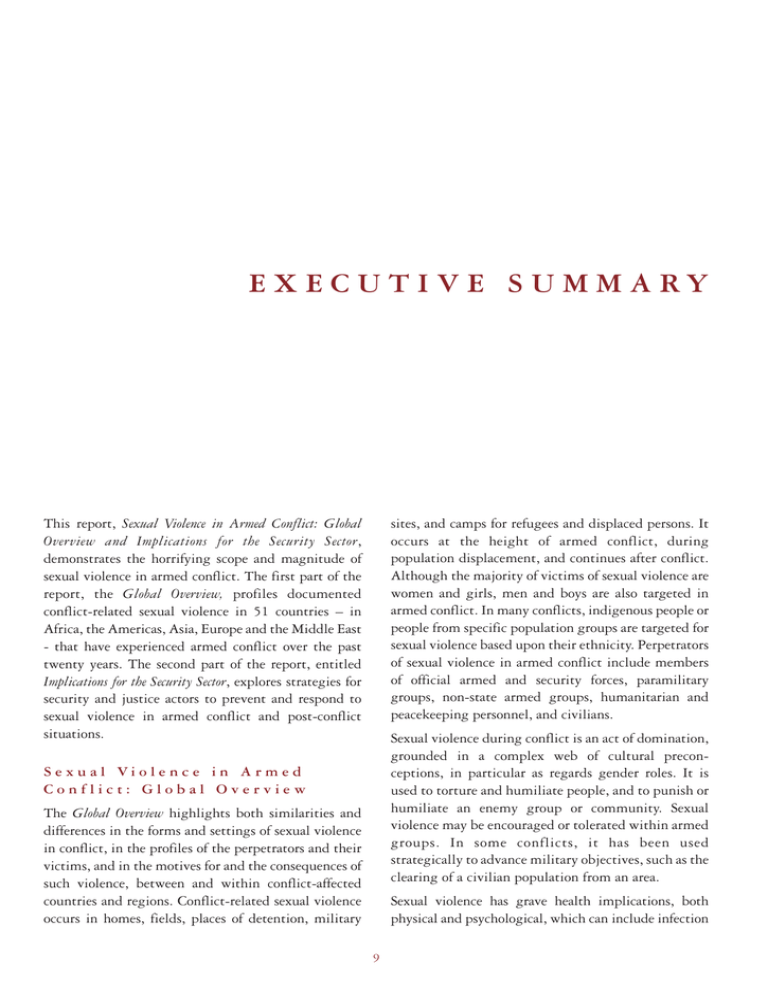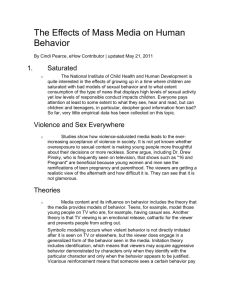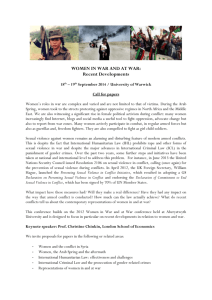
EXECUTIVE SUMMARY
This report, Sexual Violence in Armed Conflict: Global
Overview and Implications for the Security Sector,
demonstrates the horrifying scope and magnitude of
sexual violence in armed conflict. The first part of the
report, the Global Overview, profiles documented
conflict-related sexual violence in 51 countries – in
Africa, the Americas, Asia, Europe and the Middle East
- that have experienced armed conflict over the past
twenty years. The second part of the report, entitled
Implications for the Security Sector, explores strategies for
security and justice actors to prevent and respond to
sexual violence in armed conflict and post-conflict
situations.
sites, and camps for refugees and displaced persons. It
occurs at the height of armed conflict, during
population displacement, and continues after conflict.
Although the majority of victims of sexual violence are
women and girls, men and boys are also targeted in
armed conflict. In many conflicts, indigenous people or
people from specific population groups are targeted for
sexual violence based upon their ethnicity. Perpetrators
of sexual violence in armed conflict include members
of official armed and security forces, paramilitary
groups, non-state armed groups, humanitarian and
peacekeeping personnel, and civilians.
Sexual violence during conflict is an act of domination,
grounded in a complex web of cultural preconceptions, in particular as regards gender roles. It is
used to torture and humiliate people, and to punish or
humiliate an enemy group or community. Sexual
violence may be encouraged or tolerated within armed
groups. In some conflicts, it has been used
strategically to advance military objectives, such as the
clearing of a civilian population from an area.
S e x u a l Vi o l e n c e i n A r m e d
Conflict: Global Overview
The Global Overview highlights both similarities and
differences in the forms and settings of sexual violence
in conflict, in the profiles of the perpetrators and their
victims, and in the motives for and the consequences of
such violence, between and within conflict-affected
countries and regions. Conflict-related sexual violence
occurs in homes, fields, places of detention, military
Sexual violence has grave health implications, both
physical and psychological, which can include infection
9
violence, and presents examples of good or promising
practices.
with HIV/AIDS. Many survivors have little or no access
to health care and counselling services. Sexual violence
also has serious socio-economic consequences for
survivors, who are often stigmatised and marginalised.
Police reform should consider how police services can
better prevent and investigate crimes of sexual
violence, provide support to the victims, and put in
place effective measures to prevent and punish such
abuses committed by police personnel. Reform
strategies should aim to make the police service as a
whole more gender sensitive and more responsive to
gender-based violence by, for example, providing
specialised services for victims of sexual violence.
Nicaragua’s experience in gender reforms and creating
Women’s Police Stations demonstrate the benefits of
such a comprehensive approach.
Armed conflict often has consequences in terms of
sexual and gender-based violence after the shooting
has stopped. A number of countries emerging from
armed conflict report a very high and/or increasing
incidence of criminal and family violence. Impunity
for acts of sexual violence committed during the
conflict, post-conflict poverty, lack of livelihood
opportunities and the weakened rule of law, may
combine to foster increased inter-personal and sexual
violence, and to make women and girls particularly
vulnerable to sexual exploitation and trafficking.
The justice sector is responsible for providing justice
for victims of sexual violence, ensuring accountability
for the crimes committed, and supporting the longterm process of rebuilding communities. After conflict,
transitional justice bodies, including ad hoc criminal
tribunals, the International Criminal Court, Truth and
Reconciliation Commissions and reparations
programmes, should put in place mechanisms to
address the specific needs of survivors of sexual violence.
Post-conflict justice mechanisms in Sierra Leone
demonstrate some of the lessons learnt in this respect.
As societies build or rebuild judicial institutions after
conflict, legislation, national courts and traditional
justice mechanisms should be reviewed and reformed in
order to be responsive to sexual violence.
S e x u a l Vi o l e n c e i n A r m e d
Conflict: Implications for the
Security Sector
Security Council Resolution 1325 calls upon “all
parties to armed conflict to take special measures to
protect women and girls from gender-based violence,
particularly rape and other forms of sexual abuse, and
all other forms of violence in situations of armed
conflict”. It emphasises the responsibility of all states
to put an end to impunity for genocide, crimes against
humanity and war crimes relating to sexual violence.
However, there has as yet been little sharing of
experiences between states regarding the “special
measures” called for by the Security Council to protect
women and girls from rape in conflict, or on good
practice in addressing impunity for crimes of sexual
violence in armed conflict. There is a lack of
information on strategies within the security sector to
prevent and respond to sexual violence in armed
conflict and in post-conflict security sector reform.
With proper training, peacekeepers can play an
important role in protecting civilians from sexual
violence during armed conflict. The African Union
firewood patrols in Darfur demonstrate a concrete
military and policing strategy to prevent sexual
violence. Peacekeeping missions should cooperate with
and support local women’s groups to ensure that the
needs of victims of sexual violence are comprehensively
met. In peacekeeping contexts, lack of livelihood
opportunities makes the local population extremely
vulnerable to exploitation and abuse, including by
peacekeepers. Whilst the UN is now taking action to
address sexual exploitation and abuse by peacekeepers,
it is the responsibility of countries contributing troops
and police to peacekeeping operations to ensure that
strong codes of conduct and proper training are
implemented, and that there is accountability for
sexual violence. Increasing the deployment of women
in peacekeeping has been shown to contribute not only
to better relations with host communities, but also to
better conduct by peacekeepers.
The section on Implications for the Security Sector makes
linkages between the needs of survivors of conflictrelated sexual violence and the role of security sector
actors. This report focuses in particular upon responses
to conflict-related sexual violence by police, in a postconflict justice sector, by peacekeepers and in
disarmament, demobilisation and reintegration
programmes. It also includes a section highlighting
some of the ways in which civil society organisations
contribute to security. The report sets out relevant
international standards as regards security sector
responses, identifies challenges and common
shortcomings in responding to conflict-related sexual
10
monitoring and evaluation. This approach should take
into consideration the particular needs of adult male
survivors of sexual violence.
Disarmament, demobilisation and reintegration
(DDR) of former combatants is essential to establish a
secure and stable environment and to rebuild societies
after conflict. Many ex-combatants and others
associated with armed forces and groups have
experienced sexual violence, such as during conscription
or abduction into paramilitary forces. DDR
programmes should be designed to address conflictrelated sexual violence. Key priorities must be to ensure
that women and girls are not excluded from DDR; to
identify and meet the specific security and medical
needs of survivors of sexual violence; to reintegrate
survivors and perpetrators of sexual violence into
society, and to prevent such acts from reoccurring.
3
Gender training for all security sector personnel is
necessary in order to develop a gender-sensitive
capacity within security services. This should include
training to address the particular needs of victims of
sexual violence.
4
The full and equal participation of women in
the security sector should be promoted, to ensure
that security services are able to effectively identify
and respond to the needs of all members of the
community. Measures to increase the proportion of
women should include gender-sensitive recruitment
and retention strategies, and be accompanied by the
development of an organisational culture that
promotes gender equality within security services.
In many communities affected by armed conflict, state
security services provide little protection from sexual
violence and fail to adequately assist victims of such
abuse. Civil society organisations often mobilise to
fill this gap. Women’s civil society groups, in
particular, have shown notable leadership as regards
sexual violence in conflict. From Uganda to Colombia
to Tunisia, civil society organisations are doing critical
work in documenting incidents of sexual violence,
lobbying for stronger legislation, delivering training,
providing care for the victims, and taking initiatives to
ensure a more protective environment. An important
part of post-conflict reconstruction is to build and
maintain the capacity of such organisations, which can
be leaders of social and institutional change within
their communities.
5
Security sector institutions should develop
operational protocols and procedures for
assisting and supporting victims of sexual violence.
These should include, for example, protocols for
interviewing victims and investigating sexual violence
crimes, for documenting sexual violence, and for
referrals to health, social and legal services.
6
In providing services to survivors of sexual violence
during conflict, security sector institutions should
determine whether special measures are needed for
particular groups, such as children, former
combatants, and male survivors of sexual violence.
7
8
9
Improving Security Sector
R e s p o n s e s t o S e x u a l Vi o l e n c e
in Armed Conflict
Access to justice, including reparations, should be
ensured for victims of sexual violence.
Security sector institutions should develop and
prioritise operational strategies to prevent sexual
violence in armed conflict.
The report concludes with ten recommendations for
security sector institutions to improve their
prevention activities and response to sexual violence in
armed conflict.
Strict codes of conduct prohibiting sexual abuse
and exploitation by security sector personnel,
including armed forces, police, peacekeepers and
DDR staff, must be formulated, implemented with
proper training, and enforced. This is essential to
prevent sexual violence, to fight impunity and thus
ensure accountability.
1
Security sector institutions should cooperate and
coordinate with other sectors that provide
essential services to survivors of sexual violence in
conflict. These include agencies providing medical
care and psychological counselling, protection and
shelter, socio-economic support and legal advice.
Security sector actors should also coordinate and
collaborate with each other in their efforts to prevent
and respond to sexual violence.
10
Security sector institutions should seek and
support the participation of civil society and
affected communities, including women and girls, in
responding to sexual violence. Civil society
organisations may advise or provide training to security
actors, undertake awareness-raising in affected
communities, or provide essential services to victims.
2
Security sector institutions should adopt a gendersensitive approach at all stages of response to sexual
violence in conflict: in planning, implementation,
11




